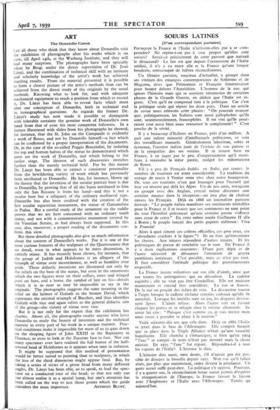ART
The Donatello Canon LET all those who think that they know about Donatello visit he exhibition of photographs after his works which is on .iew, till April 14th, at the Warburg Institute, and they will rind many surprises. The photographs have been specially taken by Brogi under the direct supervision of Dr. Jena Lanyi, and the combination of technical skill with an intimate and scholarly knowledge of the artist's work has achieved startling results. From the material presented it is possible to form a clearer picture of the artist's methods than can be achieved from the direct study of the originals by the usual methods. Knowing what to look for, and with adequate mechanical equipment to reach a position from which to record it, Dr. Lanyi has been able to reveal facts which must alter our conception of Donatello, both in technical and in iconographical questions. As regards the former Dr. Lanyi's study has now made it possible to distinguish with tolerable certainty the genuine work of Donatello's own hand from that of even his most competent followers. In a lecture illustrated with slides from his photographs he showed, for instance, that the St. John on the Campanile is evidently a work of Rosso, and not by Donatello himself—a fact which can be confirmed by a proper interpretation of the documents. Or, in the case of the so-called Poggio Bracciolini, by isolating the top and bottom halves of the statue he demonstrated which parts are the work of Donatello, and which belong to the earlier stage. The interest of such discoveries stretches further than the merely technical field. For by this means Dr. Linyi has been able to extract a consistent personality from the bewildering variety of work which has previously been attributed to Donatello. He has, for instance, blown up the theory that the invention of the secular portrait bust is due to Donatello, by proving that of all the busts attributed to him only the San Rossore is from his hand—and this is not a secular bust but a reliquary of the ordinary mediaeval type. Donatello has also been credited with the creation of the first secular equestrian monument, the statue of Gattamelata in Padua. But a careful study of the ornament on the saddle proves that we are here concerned with an ordinary tomb statue, and not with a commemorative monument erected by the Venetian Senate, as had always been supposed. In this case, also, moreover, a proper reading of the documents con- firms this view.
But these detailed photographs also give us much information about the content of Donatello's works. For it is one of the most curious features of the sculpture of the Quattrocento that no detail, even in what appears to be mere decoration, is entirely otiose. It has recently been shown, for instance, that the group of Judith and Holofernes is an allegory of the triumph of virtue over incontinence, as well as humility over pride. These didactic intentions are illustrated not only by the reliefs on the base of the statue, but even in the ornaments which the two figures wear on their collars, roses and winged putti on hers, and a horse, the symbol of lust on his—details which it is as near as may be impossible to see in the originals. The photographs suggests the same meaning in the relief on the helmet of Goliath in the bronze David, which represents the oriental triumph of Bacchus, and thus identifies Goliath with vice and again refers to the general didactic aim of the group—the victory of virtue over vice.
But it is not only for the expert that the exhibition has charms. Above all, the photographs enable anyone who loves Donatello to study the beauty of invention and the technical mastery in every part of his work in a unique manner. Prac- tical conditions make it impossible for most of us to gaze down on the sleeping figure of John XXIII in the Baptistery in Florence, or even to look at the Zuccone face to face. Nor can many spectators ever have realised the full horror of the half- severed head of Holofernes as it appears when seen in isolation.
It might be supposed that this method of presentation would be better suited to painting than to sculpture, in which the loss of the third dimension might appear fatal. But, by taking a series of views of a given head from many different angles, Dr. Lanyi has been able, so to speak, to lead the spec- tator on a conducted tour of the head; so that not only can one almost realise it as a spatial lump, but one's attention has been called on the way to just those points which the guide










































 Previous page
Previous page